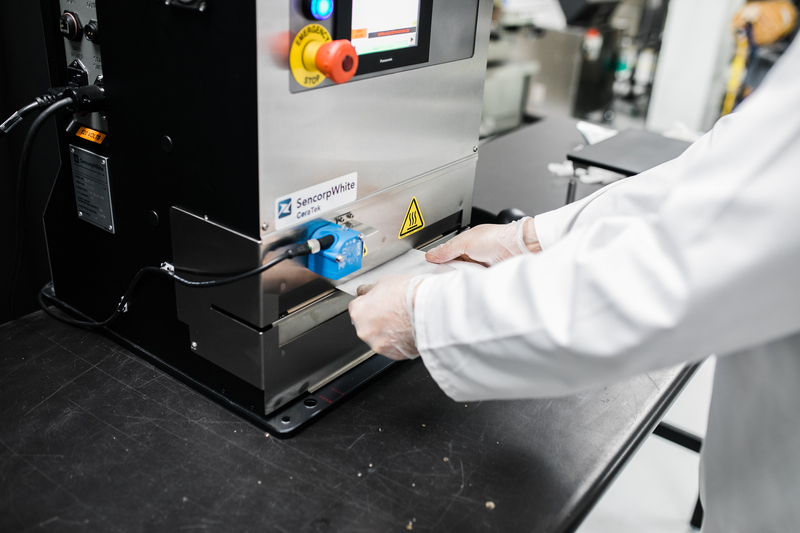Sealing Tyvek Pouches: Five Essential Areas of Focus
 In the field of medical device packaging, ensuring the sterility and integrity of the packaged products is of utmost importance. Sealing Tyvek pouches with a constant heat pouch sealer is a critical step in achieving this objective. Tyvek, a nonwoven high-density polyethylene material, possesses superior tear strength and puncture resistance.
In the field of medical device packaging, ensuring the sterility and integrity of the packaged products is of utmost importance. Sealing Tyvek pouches with a constant heat pouch sealer is a critical step in achieving this objective. Tyvek, a nonwoven high-density polyethylene material, possesses superior tear strength and puncture resistance.
Pouch sealing is an area that packaging engineers must focus on to maintain the quality of the Tyvek pouches.
Here are five areas to optimize:
Equipment Selection
Selecting the right constant heat pouch sealer is crucial for achieving consistent and reliable seals. Engineers should carefully consider factors such as seal width, temperature control capabilities, and ease of use.
It is essential to choose the right sealer for sealing Tyvek pouches. This is because it will have the appropriate settings to deal with the unique properties of the material effectively. Additionally, the equipment should be made of high-quality materials to maintain sterilization.
Seal Temperature, Pressure, and Dwell Time
Achieving the optimal combination of seal temperature, pressure, and dwell time is vital for creating a strong and hermetic seal. Engineers must determine the appropriate seal temperature based on the melting point of Tyvek. Conducting temperature mapping studies helps identify any hot or cold spots on the sealing surface, enabling adjustments to be made accordingly.
It is essential to set the right pressure and dwell time. This ensures sufficient heat and pressure are applied for a successful sterile barrier. At the same time, it prevents the pouch or the medical device from being damaged.
Validation and Monitoring
Validation of the sealing process and regular monitoring of its performance are essential for maintaining seal quality and sterility. Engineers should develop a comprehensive validation protocol that includes process and performance qualification. Seal strength testing, microbial challenge testing, and visual inspection are critical elements to ensure that the seals meet the required criteria.
Monitoring sealing parameters, such as temperature and pressure, is essential. This allows us to detect any variations or deviations that could impact seal quality. Ongoing monitoring is necessary to ensure seal quality.
Process Control
Implementing robust process control measures is essential to ensure consistency and repeatability in the sealing process. Engineers should create standard operating procedures (SOPs).
These SOPs should clearly define the steps for sealing a Tyvek pouch with a constant heat sealer. These SOPs should include guidelines for equipment setup, temperature and pressure settings, and process documentation. Regular training of operators is essential to maintain process control and reduce human error. They must be taught the correct use of the equipment and must follow standard operating procedures (SOPs).
Regulatory Compliance
Compliance with strict regulatory requirements is vital in the medical device packaging industry. Packaging engineers must be knowledgeable about regulations and guidelines.
Examples include those set by the Food and Drug Administration (FDA) and the International Organization for Standardization (ISO), such as ISO 11607 – Sterile Device Package Testing. Adhering to these regulations involves implementing appropriate design controls, documenting processes, and conducting validation activities. It is important for engineers to stay informed of the latest regulations. This ensures that packaging practices meet current standards.
Ultimately, packaging engineers can achieve reliable and consistent seals by carefully selecting the right equipment, optimizing seal temperature, pressure, and dwell time.
Validating and monitoring the process, implementing process control measures, and complying with regulatory requirements are necessary. Paying attention to critical areas is important for the integrity and success of medical device packaging. This ensures the safety and efficacy of sealed products, giving users confidence in Tyvek sterilization pouches.


 Why is Seal Strength so Important in Medical Device Packaging?
Why is Seal Strength so Important in Medical Device Packaging? In the intricate realm of modern medicine, one of the most critical yet often overlooked elements is sterile packaging. While the remarkable advancements in medical technology and treatments grab headlines, the importance of maintaining sterility through proper packaging cannot be understated.
In the intricate realm of modern medicine, one of the most critical yet often overlooked elements is sterile packaging. While the remarkable advancements in medical technology and treatments grab headlines, the importance of maintaining sterility through proper packaging cannot be understated.
